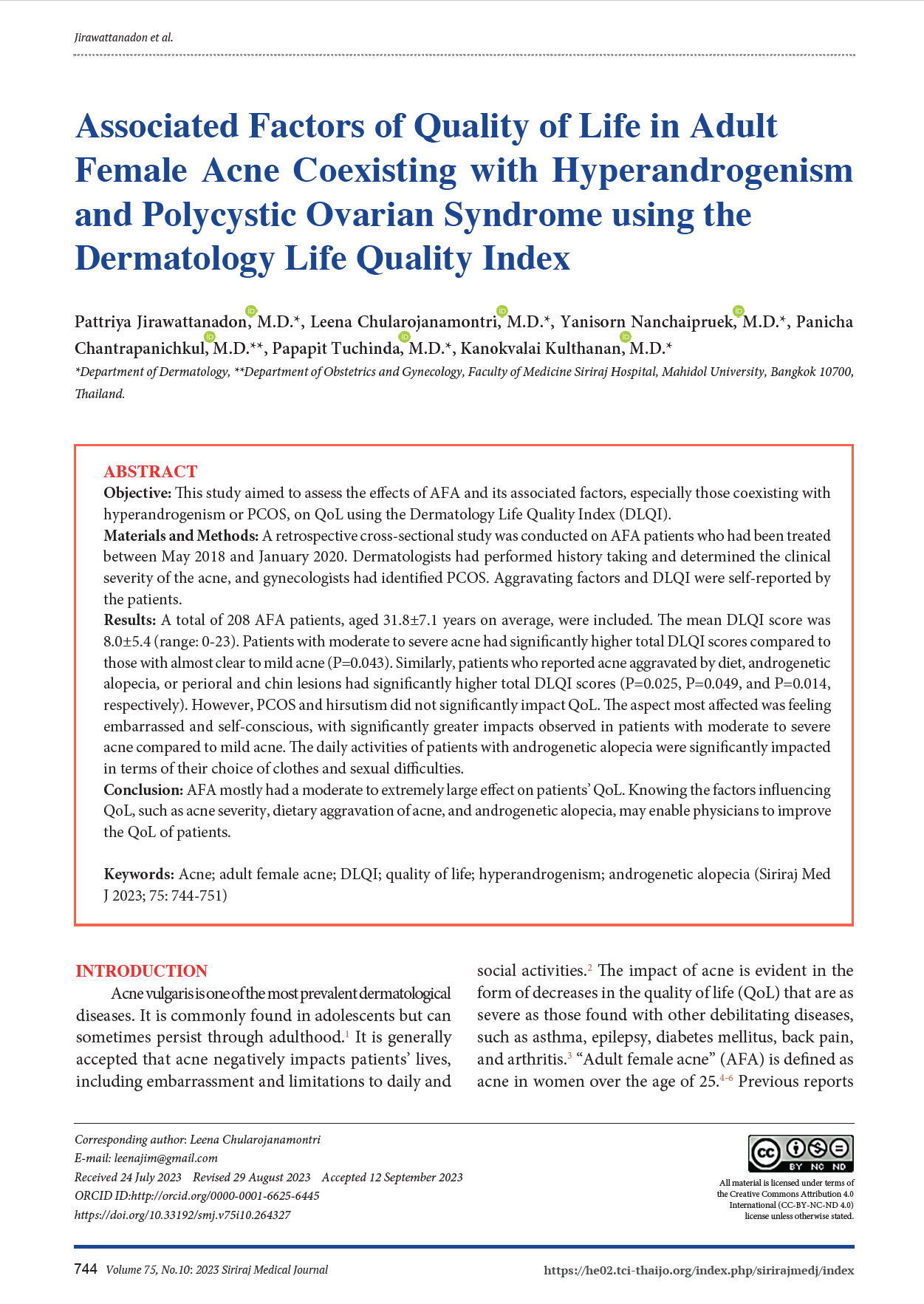Associated Factors of Quality of Life in Adult Female Acne Coexisting with Hyperandrogenism and Polycystic Ovarian Syndrome using the Dermatology Life Quality Index
DOI:
https://doi.org/10.33192/smj.v75i10.264327Keywords:
Acne, Adult female acne, DLQI, Quality of life, Hyperandrogenism, Androgenetic alopeciaAbstract
Objective: This study aimed to assess the effects of AFA and its associated factors, especially those coexisting with hyperandrogenism or PCOS, on QoL using the Dermatology Life Quality Index (DLQI).
Materials and Methods: A retrospective cross-sectional study was conducted on AFA patients who had been treated between May 2018 and January 2020. Dermatologists had performed history taking and determined the clinical severity of the acne, and gynecologists had identified PCOS. Aggravating factors and DLQI were self-reported by the patients.
Results: A total of 208 AFA patients, aged 31.8±7.1 years on average, were included. The mean DLQI score was 8.0±5.4 (range: 0-23). Patients with moderate to severe acne had significantly higher total DLQI scores compared to those with almost clear to mild acne (P=0.043). Similarly, patients who reported acne aggravated by diet, androgenetic alopecia, or perioral and chin lesions had significantly higher total DLQI scores (P=0.025, P=0.049, and P=0.014, respectively). However, PCOS and hirsutism did not significantly impact QoL. The aspect most affected was feeling embarrassed and self-conscious, with significantly greater impacts observed in patients with moderate to severe acne compared to mild acne. The daily activities of patients with androgenetic alopecia were significantly impacted in terms of their choice of clothes and sexual difficulties.
Conclusion: AFA mostly had a moderate to extremely large effect on patients’ QoL. Knowing the factors influencing QoL, such as acne severity, dietary aggravation of acne, and androgenetic alopecia, may enable physicians to improve the QoL of patients.
References
Sutaria AH, Masood S, Schlessinger J. Acne Vulgaris. StatPearls. Treasure Island (FL): StatPearls Publishing Copyright © 2022, StatPearls Publishing LLC.; 2022.
Hazarika N, Archana M. The Psychosocial Impact of Acne Vulgaris. Indian J Dermatol. 2016;61(5):515-20.
Dréno B. Assessing quality of life in patients with acne vulgaris: implications for treatment. Am J Clin Dermatol. 2006;7(2):99-106.
Bagatin E, Freitas THP, Rivitti-Machado MC, Machado MCR, Ribeiro BM, Nunes S, et al. Adult female acne: a guide to clinical practice. An Bras Dermatol. 2019;94(1):62-75.
Preneau S, Dreno B. Female acne - a different subtype of teenager acne? J Eur Acad Dermatol Venereol. 2012;26(3):277-82.
Özkesici Kurt B. Comparison of the psychosocial impact of acne in adolescents and adults; body satisfaction, self-esteem, and quality of life. J Cosmet Dermatol. 2022;21(2):836-43.
Barbieri JS, Fulton R, Neergaard R, Nelson MN, Barg FK, Margolis DJ. Patient Perspectives on the Lived Experience of Acne and Its Treatment Among Adult Women With Acne: A Qualitative Study. JAMA Dermatol. 2021;157(9):1040-6.
Anaba EL, Cole-Adeife MO. Cross-sectional study of quality of life impairment of adult female acne patients. Annals of Clinical and Biomedical Research. 2021;2(1).
Behboodi Moghadam Z, Fereidooni B, Saffari M, Montazeri A. Measures of health-related quality of life in PCOS women: a systematic review. Int J Womens Health. 2018;10:397-408.
Dréno B, Thiboutot D, Layton AM, Berson D, Perez M, Kang S. Large-scale international study enhances understanding of an emerging acne population: adult females. J Eur Acad Dermatol Venereol. 2015;29(6):1096-106.
Poli F, Dreno B, Verschoore M. An epidemiological study of acne in female adults: results of a survey conducted in France. J Eur Acad Dermatol Venereol. 2001;15(6):541-5.
Finlay AY, Khan GK. Dermatology Life Quality Index (DLQI)--a simple practical measure for routine clinical use. Clin Exp Dermatol. 1994;19(3):210-6.
Kulthanan K, Jiamton S, Wanitphakdeedecha R, Chantharujikaphong S. The validity and reliability of the Dermatology Life Quality Index (DLQI) in Thais. Thai Journal of Dermatology. 2004;20(3):113-23.
Zeichner JA, Baldwin HE, Cook-Bolden FE, Eichenfield LF, Fallon-Friedlander S, Rodriguez DA. Emerging Issues in Adult Female Acne. J Clin Aesthet Dermatol. 2017;10(1):37-46.
Chanyachailert P, Chularojanamontri L, Chantrapanichkul P, Tuchinda P, Wongwananuruk T, Sardod P, et al. Adult female acne: Clinical characteristics and factors significantly associated with polycystic ovary syndrome. Australas J Dermatol. 2021;62(4):e532-e8.
Teede HJ, Misso ML, Costello MF, Dokras A, Laven J, Moran L, et al. Recommendations from the international evidence-based guideline for the assessment and management of polycystic ovary syndrome. Hum Reprod. 2018;33(9):1602-18.
Appropriate body-mass index for Asian populations and its implications for policy and intervention strategies. Lancet. 2004;363(9403):157-63.
Lasek RJ, Chren MM. Acne vulgaris and the quality of life of adult dermatology patients. Arch Dermatol. 1998;134(4):454-8.
Suthipinittharm P, Noppakun N, Kulthanan K, Jiamton S, Rajatanavin N, Aunhachoke K, et al. Opinions and perceptions on acne: a community-based questionnaire study in Thai students. J Med Assoc Thai. 2013;96(8):952-9.
Kulthanan K, Jiamton S, Kittisarapong R. Dermatology Life Quality Index in Thai Patients with Acne. Siriraj Med J. 2007;59:3-7.
Gupta A, Sharma YK, Dash KN, Chaudhari ND, Jethani S. Quality of life in acne vulgaris: Relationship to clinical severity and demographic data. Indian J Dermatol Venereol Leprol. 2016;82(3):292-7.
Gorelick J, Daniels SR, Kawata AK, Degboe A, Wilcox TK, Burk CT, et al. Acne-Related Quality of Life Among Female Adults of Different Races/Ethnicities. J Dermatol Nurses Assoc. 2015;7(3):154-62.
Cash TF. The psychosocial consequences of androgenetic alopecia: a review of the research literature. Br J Dermatol. 1999;141(3):398-405.
Gupta S, Goyal I, Mahendra A. Quality of Life Assessment in Patients with Androgenetic Alopecia. Int J Trichology. 2019;11(4):147-52.

Published
How to Cite
License
Copyright (c) 2023 Siriraj Medical Journal

This work is licensed under a Creative Commons Attribution-NonCommercial-NoDerivatives 4.0 International License.
Authors who publish with this journal agree to the following conditions:
Copyright Transfer
In submitting a manuscript, the authors acknowledge that the work will become the copyrighted property of Siriraj Medical Journal upon publication.
License
Articles are licensed under a Creative Commons Attribution-NonCommercial-NoDerivatives 4.0 International License (CC BY-NC-ND 4.0). This license allows for the sharing of the work for non-commercial purposes with proper attribution to the authors and the journal. However, it does not permit modifications or the creation of derivative works.
Sharing and Access
Authors are encouraged to share their article on their personal or institutional websites and through other non-commercial platforms. Doing so can increase readership and citations.














